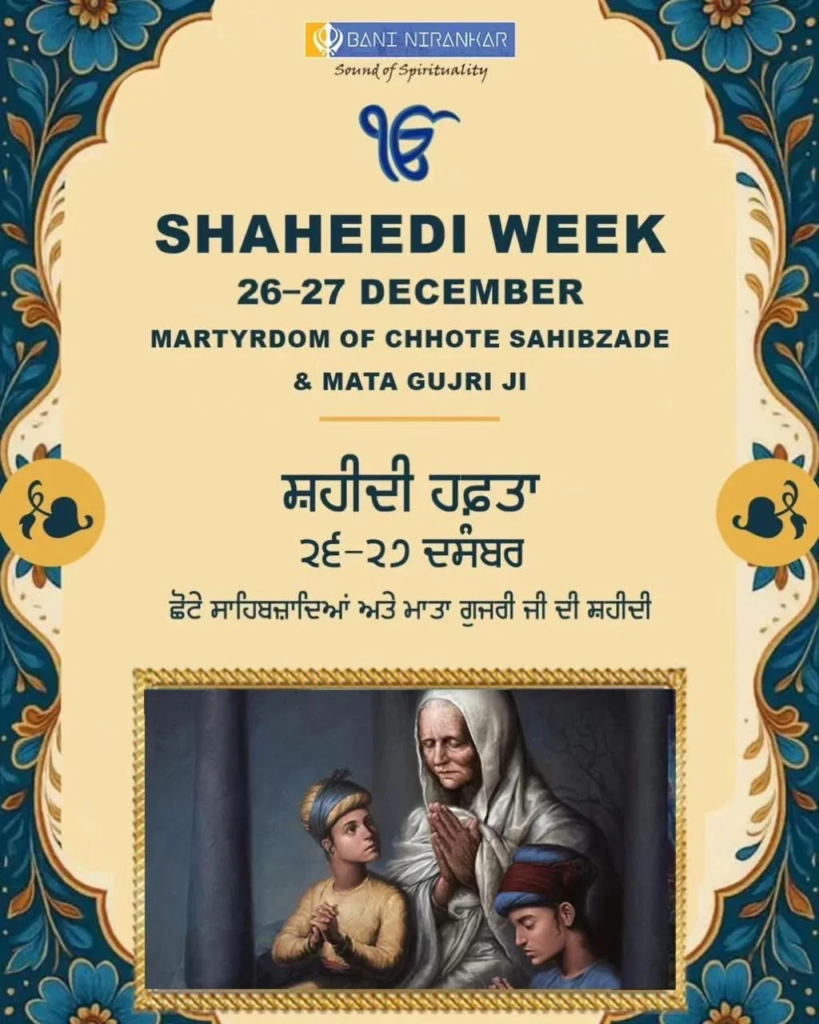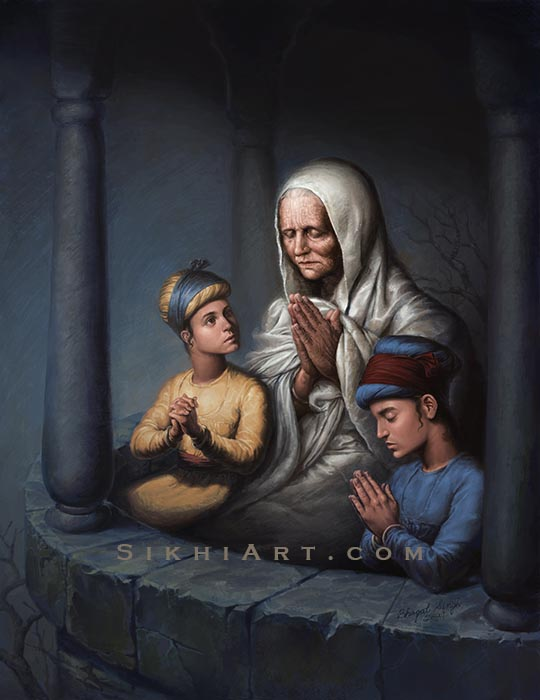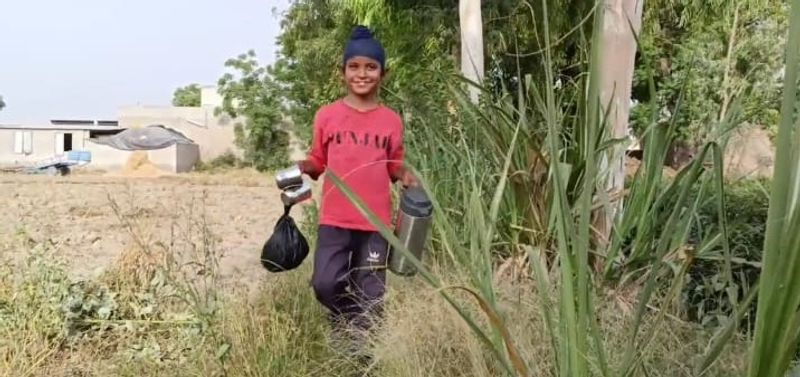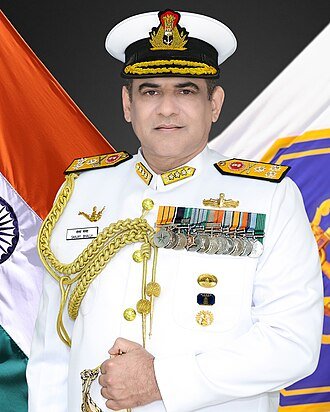Current Events :










Chote Sahibzade” (Little Princes) refers to the two youngest sons of Guru Gobind Singh, Sahibzada Zorawar Singh (age 9) and Sahibzada Fateh Singh (age 6), who attained martyrdom in Sirhind in 1704, refusing to convert to Islam and famously being bricked alive by the Mughals, symbolizing ultimate bravery and commitment to faith, an event commemorated annually in December as Saka Sirhind.










adhaar-PAN linking: How to apply for e-PAN using Aadhaar Card without paying any money? Check step-by-step guide
https://dhunt.in/12V8Cx

The Indian Army has brought a change in its social media guidelines under which its personnel can now sign up on Instagram, but with a rider that they can use it only as “passive observers” without putting up posts or comments on the platform, sources said on Thursday.
Advertisement
https://syndicatedsearch.goog/afs/ads?sjk=SeLZY%2FrKQkK5EpvZDmPm1Q%3D%3D&psid=2064713548&client=pub-8115901613940036&r=m&sct=ID%3Dbfa6c1a57628ce30%3AT%3D1757226862%3ART%3D1757226862%3AS%3DALNI_MbBMmz-OYw0LKbpxGYEOkvPbafHVg&sc_status=6&rpbu=http%3A%2F%2Fwww.tribuneindia.com%2Fafsearch%3Fafs%26partner_param%3Dparam&rpqp=query&type=3&rs_tt=c&oe=UTF-8&ie=UTF-8&fexp=21404%2C17300003%2C17301431%2C17301432%2C17301436%2C17301548%2C17301266%2C72717107&format=r4&nocache=4391766732500628&num=0&output=afd_ads&domain_name=www.tribuneindia.com&v=3&bsl=8&pac=0&u_his=9&u_tz=240&dt=1766732500629&u_w=1536&u_h=864&biw=1216&bih=556&psw=1217&psh=4381&frm=0&uio=-&cont=relatedsearches2&drt=0&jsid=csa&nfp=1&jsv=842209568&rurl=https%3A%2F%2Fwww.tribuneindia.com%2Fnews%2Findia%2Farmy-personnel-can-now-sign-up-on-instagram-but-as-passive-observers-sources%2F&referer=https%3A%2F%2Fwww.tribuneindia.com%2F
The move aims to augment the awareness level of Army personnel in the “digital age of information” and guard them against any potential or inadvertent leak of sensitive information, they said.
Advertisement
The revision in guidelines was introduced a few days ago, and applies to all ranks in the Indian Army, a source in the defence establishment said.
Advertisement
“The revised guidelines essentially mean that Army personnel can now sign up on Instagram, but with the condition that they can use it only as passive observers. They can view posts, but cannot post content or comments on the platform,” the source said.
Essentially, no “user-generated content” is allowed, so even ‘liking’ a post would fall in that category, the source added.
Read More
Advertisement
Earlier, Army personnel could sign up and use X, but not Instagram.
“The restrictions already apply on X, so Army personnel using X can only view posts, but cannot post, repost or comment on them,” another source said.
“The reason behind this change in guidelines is essentially that the information age is changing, and the Army cannot keep itself away from this information world,” the source said.
Through social media, Army personnel can see, observe and gain information, and keep themselves abreast of the happenings in and out of the country, the sources said.
“But, one has to ensure that no sensitive information is leaked inadvertently on social media platforms, and hence they have to use them as passive observers,” they said.
During an interactive session held here in November as part of the Chanakya Defence Dialogue, Army Chief General Upendra Dwivedi had emphasised the necessity of keeping a smartphone.
However, he also underlined the difference between “reacting impulsively” and “responding thoughtfully”.
A soldier can keep in touch with his family or read e-books online, so a smartphone is a necessity today, Gen Dwivedi had said when asked how the Army looks at Gen Z, given that they are set to play a major role in the making of a Viksit Bharat.
Today’s generation is “socially conscious, digitally fluent globally connected”,nt an

As the hostilities escalated during “Operation Sindoor” and swarms of drones hovered over Ferozepur district, 10-year-old Shavan Singh from Tarawali village served water, lassi, milk and tea to jawans. This gesture of the Class IV student won the hearts of many.
In recognition of Shavan’s patriotic spirit and selfless service, the Army’s Golden Arrow Division had bestowed him with the title of “Youngest Civil Warrior” and decided to sponsor his education. Western Army Commander Lt Gen Manoj Kumar Katiyar had felicitated Shavan, highlighting the Army’s bond with the people.
Now, in recognition of his gesture, Shavan has been selected for the “Pradhan Mantri Rashtriya Bal Puraskar”, which will be conferred on him by President Droupadi Murmu on December 26. Speaking to The Tribune, Shavan’s father Sona Singh said jawans camped in their fields during Operation Sindoor. “From the very first day, Shavan insisted on serving soldiers. He kept taking refreshments to them and enjoyed being in their company,” Sona said, adding that he never imagined that his younger son would be given such an honour.
Shavan said, “I love being around soldiers. I used to serve them cold water and milk every day. I want to grow up and serve the nation in uniform.” “I have even bought new clothes. I am looking forward to meet the President and the Prime Minister,” he said.
Shavan’s mother Santosh Rani said, “He dreams of becoming a soldier one day.” “The jawans became his friends. They loved what he did for them,” said Santosh, while thanking the military for recommending his name for the award.

Prime Minister Narendra Modi will participate in the national program organised on the occasion of Veer Bal Diwas here on Friday.
He will also interact with the recipients of the Pradhan Mantri Rashtriya Bal Puraskar.
In a post on X, the Prime Minister said, “Veer Baal Diwas is a day of reverence, dedicated to remembering the sacrifice of the brave Sahibzades. We recall the unshakeable faith of Mata Gujri Ji and the immortal teachings of Sri Guru Gobind Singh Ji. This day is associated with courage, conviction and righteousness. Their lives and ideals will continue to motivate people for generations.”
The Centre is organising several programmes across the country to educate people about the extraordinary courage and supreme sacrifice of the sons of Guru Gobind Singh – Sahibzade Baba Jorawar Singh and Baba Fateh Singh – and to honour the indomitable valour of young heroes in Indian history.
These activities include storytelling sessions on heroic figures, poetry recitation, poster-making and essay-writing competitions. These programmes will be conducted in schools, child care institutions, Anganwadi centres and other educational establishments, as well as through online platforms such as My Gov and My Bharat.
In 2022, the Prime Minister announced that December 26 would be observed as Veer Bal Diwas so that the martyrdom of the Sahibzades, whose sacrifices continue to inspire generations, will always be remembered.
Meanwhile, BJP National Working President Nitin Nabin, accompanied by party leaders, visited Bangla Sahib Gurudwara to offer prayers.

The United States on Thursday (local time) launched a “deadly” strike against the terror organisation Islamic State in northwest Nigeria, said President Donald Trump.
Donald Trump, in a social media post on Truth Social, said that the strike targeted terrorists over the alleged killings of Christians.
“Tonight, at my direction as Commander in Chief, the United States launched a powerful and deadly strike against ISIS Terrorist scum in Northwest Nigeria, who have been targeting and viciously killing, primarily, innocent Christians, at levels not seen for many years, and even centuries! I have previously warned these terrorists that if they did not stop the slaughtering of Christians, there would be hell to pay, and tonight, there was,” Trump said.
“The Department of War executed numerous perfect strikes, as only the United States is capable of doing. Under my leadership, our country will not allow radical Islamic terrorism to prosper. May God bless our military, and MERRY CHRISTMAS to all, including the dead terrorists, of which there will be many more if their slaughter of Christians continues,” the US President added.
According to the US National Counterterrorism Centre, “ISIS-West Africa was formed in 2015 when Boko Haram pledged allegiance to ISIS. The branch, as per the United States, attacks regional military targets and civilian defence forces and frequently attacks government personnel and infrastructure, and Christians.”






















































